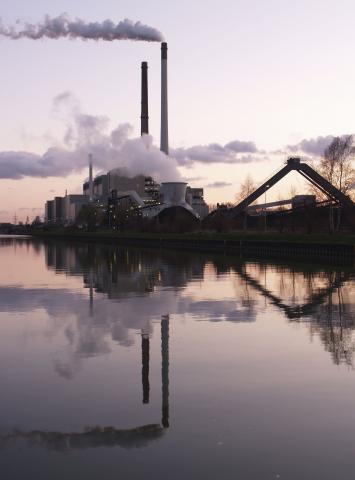The American Lung Association recently released their annual report, State of the Air (SOTA) 2011. There were some positive findings, such as that air quality improved in many places from 2007-2009. There were also some negative findings, like that over 154 million people (yes, over half the nation) still suffer from pollution levels that can be dangerous to breathe. With data like this, it’s time to look at sources of air pollution, namely coal-fired power plants and sea-going vessels.
Janice Nolen, assistant vice president of national policy and advocacy for the ALA, discussed coal-fired power plants and sea-going vessels during an interview that I conducted with her for The Huffington Post.
Regarding coal-fired power plants, Nolen discussed the report that the ALA released earlier this year, “Toxic Air: The Case For Cleaning Up Coal-Fired Power Plants,” in which the ALA states that particle pollution from power plants kills an estimated 13,000 people per year, and the greatest contributor to this hazardous pollution is coal-fired power plants.
When asked if there is such a thing as “clean coal,” Nolen stated that the ALA is still evaluating its energy policies, and has not yet adopted one on that position. But, Nolen remarks,
SOTA 2011 cites coal-fired power plants as one of the largest contributors to particulate pollution, ozone, and global warming. “Their pollution blows across state lines into states thousands of miles away.” The ALA says the EPA must finalize steps to clean up and cut emissions, and urges Congress to support the EPA’s actions.
Regarding year-round particle pollution, eight cities were found to have levels above the national standard. While eight may seem like a small number of cities to be above the national standard, the standard level itself has been called into question. Despite the fact that the EPA’s official science advisors recommended nearly unanimously that the standard for fine particles should be improved, the EPA did not strengthen it, SOTA 2011 reports.
Nearly 61 million Americans live in counties with too many days of harmful spikes in particle pollution. These spikes can increase the risk of heart attack, stroke, and early death. 16 cities with the worst-ranked short-term levels of particle pollution did worse than in previous years.
Bakersfield, CA is ranked the worst in two particle pollution categories. When asked about Bakersfield, Nolen defended the area, and cited ocean-going vessels as a reason that some regions struggle to control their air pollution.
Nolen went on to state that ocean-going vessels use fuel with as much as 45,000 ppm of sulfur, compared to the U.S. limit of just 15 ppm of sulfur permitted in diesel fuel.
According to Nolen, the pollution produced by ocean-going vessels has recently received more attention, and now the EPA is “working diligently” to reduce those emissions, a process that is complicated by international politics.
The EPA’s website states that large ships are a significant contributor to air pollution in many U.S. cities. While the International Maritime Emission Reduction Scheme reports that there was no outcome relating to international maritime transport at Cancun’s climate change talks last year, the EPA finalized emissions standards for new marine diesel engines in 2010. According to the EPA’s website, near-term emissions standards are set to begin in 2011, while long-term standards will begin in 2016. If more vessels comply with the new standards, the EPA estimates that in 2020, up to 14,000 premature deaths could be prevented. The American Lung Association has been an advocate of EPA measures to protect people from shipping air pollution.
Not everyone is thrilled with the ALA’s SOTA reports. According to Nolen,
Following the release of SOTA 2010, Arizona’s Dept. of Environmental Quality Director, Benjamin H. Grumbles, questioned the report, which had found that the Phoenix-Mesa-Scottsdale, AZ metropolitan area moved to the top of the list of cities most polluted by year-round particle levels. Grumbles said that there was only one air quality monitor near the Cowtown area of western Pinal County, 40 miles from downtown Phoenix. He also says information was based on outdated levels which had since improved.
Nolen admits that the data is based on the past few years. The 2011 report contains data from 2007, 2008, and 2009. Nolen says, “This is not the absolute end all, but it’s the best that we have… And it’s a really good system.”
Regarding attempts by House Energy and Commerce Chairman Fred Upton (R-MI) to weaken the EPA’s regulations under the Clean Air Act, Nolen says, “To not understand and appreciate the Clean Air Act and the EPA’s requirements to follow the Clean Air Act, to not see what the benefits of that are – it’s just something we don’t understand.”
The SOTA report suggests that the EPA should set new pollution standards for cars, light trucks, SUVs and gasoline fuels. The ALA wants this done because of evidence that people who live or work near high-traffic areas bear the brunt of the health consequences of air pollution. In addition, the ALA says that Congress should fund EPA’s diesel cleanup program.
The full report and opportunities to get involved are available on the State of the Air website.
Action must be taken now so that future SOTA reports don’t just feature improvements, but tout actual successes in combating air pollution.
Photo credit: Arnold Paul
Subscribe to our newsletter
Stay up to date with DeSmog news and alerts






